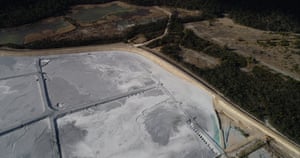Environmental Justice Australia report finds problems at ash dumps in every mainland state
Soon after Sue Wynn moved up the road from the Vales Point coal
power station, on the banks of Lake Macquarie in New South Wales’s
Hunter Valley, she started to worry about what the plant was releasing
into the environment.
Not the carbon dioxide emissions from its smokestacks – it was 1978, and that disquiet came later – but the coal ash mixed with water and piped into a giant unlined dam site nearby.
“What you have is a poisonous slurry containing heavy metals being dumped over virgin soil,” Wynn, a former Wyong councillor for the Greens, says. “My concern is that it is leaching into the water table and Lake Macquarie and is going to continue to for hundreds of years.”
According to research by the Hunter Community Environment Centre,
that concern has some basis. It found water and sediment near discharge
points from the Vales Point and the Eraring power stations had levels
of arsenic, nickel, aluminium, copper and lead that were likely to harm
aquatic life. As Wynn notes, Lake Macquarie is a favoured spot for
anglers.Not the carbon dioxide emissions from its smokestacks – it was 1978, and that disquiet came later – but the coal ash mixed with water and piped into a giant unlined dam site nearby.
“What you have is a poisonous slurry containing heavy metals being dumped over virgin soil,” Wynn, a former Wyong councillor for the Greens, says. “My concern is that it is leaching into the water table and Lake Macquarie and is going to continue to for hundreds of years.”
“Maybe there is not enough there to have an impact on us as humans – I don’t know – but bottom feeders will be picking up the mercury and cadmium and that will flow through other animals,” she says. “I don’t know how long the fish life can tolerate that before it becomes an issue but it has to be having an effect on marine life.”
A new report by Environmental Justice Australia, a not-for-profit legal group formerly known as the Victorian Environment Defenders Office, says Lake Macquarie is an example of a wider problem: poor management of, and limited publicly available information about, health risks associated with ash dams at the country’s coal plants.
The findings are dismissed by some in the energy industry, who say the report is part of a long-running campaign to shut down coal-fired electricity due to concern about climate change.
While the planet-warming emissions from coal plants are frequently discussed, the ash byproduct is not. It is estimated more than 400m tonnes of coal ash are stored across Australia, increasing by between 10m and 12m tonnes a year.
The report says toxins in coal ash have been linked to asthma, heart disease, cancer, respiratory disease and stroke. It cites the US Environmental Protection Agency, which found the risk of public exposure from ash dams can last for decades, peaking 78 to 105 years after ash storage begins.

Report author Bronya Lipski says the issue has largely flown under the public radar. “Given the size of them, and the sheer extent of the toxic material they have in them, you would think there would be much greater monitoring and far more information available to the public,” she says. “It really is a ticking time bomb.”
Delta Electricity, which owns Vales Point, rejects this. It says the Environmental Justice Australia report is misleading and the water sampling it quotes unscientific. Delta secretary Steve Gurney says the company does its own testing in line with Environment Protection Authority methodology and posts the results on its website.
“Environmental Justice Australia is a group of anti-coal activists with one objective, to shut down coal-fired power stations,” he says.
A spokesman for Origin Energy, which owns the Eraring station, says the company takes local environment protection seriously and also does its own water quality monitoring beyond what is required under law.
Industry group the Australian Energy Council said it was yet to see the report but it appeared a continuation of a campaign against fossil fuels. “Plant operators work within strict licence limits and these are independently and continuously monitored,” a spokesman says.
The risk associated with coal ash dams on the NSW central coast made headlines in March, when a lakeside sport centre was abruptly closed after engineers for Origin found it would not be safe if an earthquake collapsed the Eraring ash dump wall. The Myuna Bay Sports and Recreation Centre remains shut.
Environmental Justice Australia says the most poorly constructed ash dams should be moved and the existing sites cleaned up. It says all jurisdictions should introduce bonds to ensure landfill dumps are properly managed.
The group wants state parliaments to set-up inquiries to better understand and make public the risk to health and the environment, building on a federal Senate inquiry into commonwealth responsibility for mining rehabilitation last year. And it recommends imposing an immediate obligation on dump owners and operators to convert wet dumps to dry ash landfill and to prepare best practice rehabilitation and closure plans in consultation with affected communities.
Wynn, now the secretary of community group Myuna Bay Sports and Recreation Centre, says some people were alarmed when the environment centre published NSW Office of Environment and Heritage data suggesting cadmium levels in Lake Macquarie crabs were too high for consumption. The EPA has advised they are safe to eat in small portions.
She hopes to see pollution standards strengthened and wants greater transparency.
“Quite frankly, I think the state government should be testing all the fish life, checking if it is safe to eat and we in the community should be informed,” she says. “At the moment we’re being kept in the dark.”

No comments:
Post a Comment